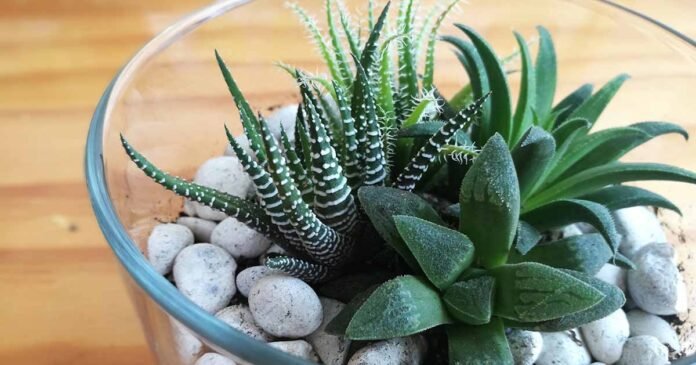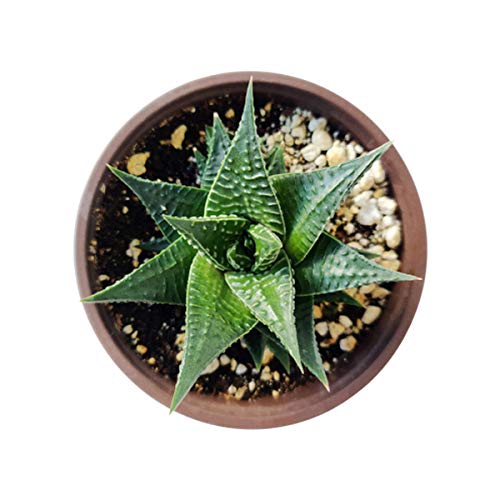During dormancy, usually in summer and fall, you’ll find that you only need to water about once a month. You may want to invest in a moisture meter to guide you.
Learn more about watering succulents here.
Fertilizer
Feed plants over the age of one year once a month during the growing season. Use a liquid houseplant food intended for succulents diluted to 50 percent.
Species to Select
The following species are samples of what the Haworthia genus has to offer to the indoor succulent gardener:
Cathedral Window
H. cymbiformis, commonly known as cathedral window haworthia, star window, or window, has smooth-leaved rosettes.
The striping and translucent characteristics of the rounded leaf tips are examples of “epidermal windows” that facilitate light absorption for photosynthesis.
Cathedral window plants are available via Amazon in two-inch pots.
Mature dimensions are approximately three inches tall and four inches wide.
Fairy Washboard
Fairy washboard haworthia, H. limifolia, has flattened rosettes of ridged, pointed leaves.
Rosettes grow to approximately four inches tall and five inches wide.
Fairy washboard plants are available via Amazon in four-inch pots.
Spider-Nest
H. arachnoidea is known as spider-nest haworthia for its rounded mound of soft, translucent bristles. You may also find it listed as cobweb aloe or paper rose haworthia.


A unique survival feature is the contraction of the foliage to conserve water in times of extreme heat and drought that causes the rosette to close up into a ball.
Its mature height is about two inches. Rosettes may spread from five to seven inches across.
Zebra
The zebra plant, Haworthiopsis attenuata, was classified as Haworthia until 2019.
Now it is Haworthiopsis, a separate genus for flora like Haworthia that have a thicker epidermis or outer leaf covering. But you’ll often still see these referred to as haworthias today nonetheless.
Although there are many other fascinating species, zebra may be the one most people associate with the word haworthia.
The features of this species include upright rosettes with white “tubercules” that allow for plant expansion and contraction during wet and dry periods.
Dimensions at maturity are about four to six inches wide and six to eight inches tall.
Zebra plants are available via Amazon in two- and four- inch starter pots and two- and four-inch clay pots.
Learn more about growing zebra plants here.
Maintenance
The main task is to monitor water needs.
Prolonged dehydration may lead to foliar desiccation, browning, and death.


If you underwater, a little wilting isn’t usually a problem, provided you soak the soil deeply once you detect the moisture stress.
Overwatering is likely to lead to rotting. Yellowing foliage is an indication of oversaturation.
The foliage may exhibit other signs of distress. Purple or red may be the result of exposure to direct sunlight or proximity to a grow light.


And finally, you may want to repot every three years or so. Whether your plant has outgrown its current container or not, it’s good to refresh depleted soil periodically.
Propagation
There are several ways to start your own haworthia collection.
Let’s look at each.
From Seed
If you have a plant, you can try to collect the tiny seeds from the pods that form after the flowers bloom.





